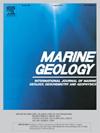How do morphological characteristics affect tidal asymmetry in the Radial Sand Ridges?
IF 2.6
3区 地球科学
Q2 GEOSCIENCES, MULTIDISCIPLINARY
引用次数: 0
Abstract
While it is widely recognized that the Radial Sand Ridges (RSR) in the South Yellow Sea are predominantly shaped by tidal forces, there remains a limited understanding of how this distinctive morphological configuration—characterized by an interlaced channel-ridge system—can subsequently influence local tidal dynamics. This study examines the effects of morphological features on tidal asymmetry, taking into account seabed slope, relative depths between ridges and channels, and channel convergence. Three principal indices—namely tidal-duration-asymmetry (TDA), peak-current-asymmetry (PCA), and slack-water-asymmetry (SWA)—are employed to quantify various dimensions of tidal asymmetry. The findings indicate that SWA serves as the most morphology-sensitive indicator, whereas TDA exhibits minimal sensitivity to morphological changes. Furthermore, seabed steepness emerges as a critical factor influencing tidal asymmetry within the RSR; steeper slopes enhance intrinsic energy conversion processes, thereby inducing tidal asymmetries. Additional analysis reveals that streamwise advection accounts for an average of 88 % of total advection scale while controlling for spatial heterogeneity. Specifically, the average integral sum of advection terms along submerged sand ridges is 2.53 times greater than that along the deepest section of the tidal channel line—a significant contributor to spatial variability in SWA. With a positive seabed slope, the apex of the RSR acts as a source for overtides which interact with incoming astronomical tides, consequently generating tidal asymmetries. Moreover, this study illustrates varying dependencies of tidal asymmetry on bottom stress across channels and ridges, contributing to spatial variability in arc direction among RSRs. Ultimately, this research elucidates complex interactions between tidal flow and morphological characteristics within RSRs and provides insights into tide evolution in analogous ebb-shoal systems.
形态特征如何影响径向沙脊的潮汐不对称性?
虽然人们普遍认为南黄海的径向沙脊(RSR)主要是由潮汐力形成的,但对于这种以交错的海峡-海脊系统为特征的独特形态构造如何影响当地的潮汐动力学,人们的了解仍然有限。本研究考察了形态特征对潮汐不对称性的影响,同时考虑了海床坡度、海脊与水道之间的相对深度以及水道汇聚等因素。研究采用了三个主要指数--潮汐-持续时间-不对称(TDA)、峰值-海流-不对称(PCA)和松弛水-不对称(SWA)--来量化潮汐不对称的各个维度。研究结果表明,SWA 是对形态最敏感的指标,而 TDA 对形态变化的敏感性最小。此外,海床陡度是影响 RSR 内潮汐不对称性的一个关键因素;较陡的斜坡会增强内在能量转换过程,从而诱发潮汐不对称性。其他分析表明,在控制空间异质性的情况下,流向平流平均占总平流尺度的 88%。具体来说,沿水下沙脊的平流项平均积分总和是沿潮汐通道线最深段平流项平均积分总和的 2.53 倍--这是造成 SWA 空间变化的重要原因。由于海底坡度为正,RSR 的顶点成为潮汐过量的来源,潮汐过量与天文潮相互作用,从而产生潮汐不对称。此外,这项研究还说明了潮汐不对称性对海峡和海脊底部应力的不同依赖性,从而导致了 RSR 之间弧线方向的空间变化。最终,这项研究阐明了潮汐流与 RSR 内部形态特征之间复杂的相互作用,并为了解类似退潮-浅滩系统中的潮汐演变提供了见解。
本文章由计算机程序翻译,如有差异,请以英文原文为准。
求助全文
约1分钟内获得全文
求助全文
来源期刊

Marine Geology
地学-地球科学综合
CiteScore
6.10
自引率
6.90%
发文量
175
审稿时长
21.9 weeks
期刊介绍:
Marine Geology is the premier international journal on marine geological processes in the broadest sense. We seek papers that are comprehensive, interdisciplinary and synthetic that will be lasting contributions to the field. Although most papers are based on regional studies, they must demonstrate new findings of international significance. We accept papers on subjects as diverse as seafloor hydrothermal systems, beach dynamics, early diagenesis, microbiological studies in sediments, palaeoclimate studies and geophysical studies of the seabed. We encourage papers that address emerging new fields, for example the influence of anthropogenic processes on coastal/marine geology and coastal/marine geoarchaeology. We insist that the papers are concerned with the marine realm and that they deal with geology: with rocks, sediments, and physical and chemical processes affecting them. Papers should address scientific hypotheses: highly descriptive data compilations or papers that deal only with marine management and risk assessment should be submitted to other journals. Papers on laboratory or modelling studies must demonstrate direct relevance to marine processes or deposits. The primary criteria for acceptance of papers is that the science is of high quality, novel, significant, and of broad international interest.
 求助内容:
求助内容: 应助结果提醒方式:
应助结果提醒方式:


